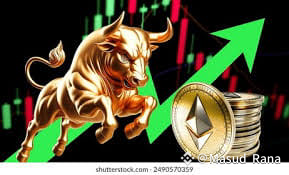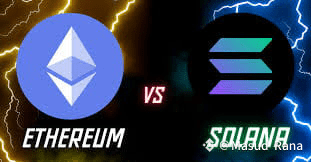In the ever-evolving world of crypto, two Layer-1 giants stand out for building the decentralized internet: Ethereum (ETH) and Solana (SOL). While Ethereum remains the industry pioneer, Solana has emerged as a fast, cost-effective challenger. Let’s break down where they stand in 2025 — from technology and adoption to price action and future potential.

⚙️ Technology: Speed vs Security
Ethereum, launched in 2015, revolutionized crypto by introducing smart contracts. It runs thousands of dApps and powers a vast DeFi and NFT ecosystem. Since its shift to Proof-of-Stake (The Merge), Ethereum is more energy-efficient, but still struggles with scalability and high gas fees — especially during network congestion.
Solana, on the other hand, is known for blazing-fast transactions (up to 65,000 TPS) and ultra-low fees (less than $0.01). It uses a unique hybrid consensus model called Proof-of-History (PoH) + Proof-of-Stake, making it one of the most efficient Layer-1 chains. However, it has faced network outages in the past — though new upgrades like Firedancer, a new validator client, aim to solve this.
🌐 Ecosystem Growth & Use Cases
Ethereum is still the top choice for institutional investors and developers. Leading DeFi protocols like Uniswap, Aave, and MakerDAO are built on Ethereum. It also dominates the NFT market, with platforms like OpenSea relying heavily on the ETH network.
Solana, however, has gained momentum in emerging sectors like DePIN (Decentralized Physical Infrastructure), gaming, and AI-integrated dApps. Solana Pay is being integrated into real-world merchants, and its NFT ecosystem (like Mad Lads and Tensor) is booming. Wallets like Phantom and Solflare offer a smoother user experience than many ETH-based apps.
📈 Market Performance & Price Trends
As of July 2025:
Ethereum (ETH) is trading near $3,600, showing steady growth post-ETF approval and EIP-4844 upgrades (proto-danksharding).
Solana (SOL) has reclaimed the $140–$150 range, with analysts projecting a run toward $180 if bullish momentum continues.
Ethereum remains the second-largest cryptocurrency by market cap, while Solana holds firm in the top 5, consistently gaining market share.
Many traders view SOL as an “Ethereum of the East”—faster, lighter, but still developing in terms of stability. ETH, while slower, is trusted and battle-tested.

🔮 Future Outlook
Ethereum’s roadmap includes full sharding, account abstraction, and further gas optimizations. This will dramatically boost scalability and developer capabilities, keeping ETH a strong long-term play.
Solana’s path involves improving validator diversity (via Firedancer), launching new dApps, and growing adoption in regions like Asia and Latin America.
Both ecosystems are drawing massive venture capital and developer talent.
🪙 Which One Should You Watch?
Choose ETH if you value long-term stability, institutional adoption, and regulatory resilience.
Choose SOL if you want speed, low fees, and exposure to high-growth niches like gaming and DePIN.
Smart traders hold both — using SOL for real-time transactions and ETH for long-term investment.
📝 Final Thoughts
Ethereum and Solana aren’t enemies — they are shaping different layers of the Web3 future. As the crypto world matures, multi-chain will be the norm. Whether you're building, trading, or holding, staying informed is your strongest asset.
💬 Drop your thoughts: Are you team $ETH, team $SOL — or both?
🔔 Follow for real-time crypto updates, airdrop news, and strategy tips on Binance Square!
#Ethereum #Solana #ETH #SOL #CryptoNews #BinanceSquare #Web3 #DeFi #Layer1 #Blockchain #Crypto2025